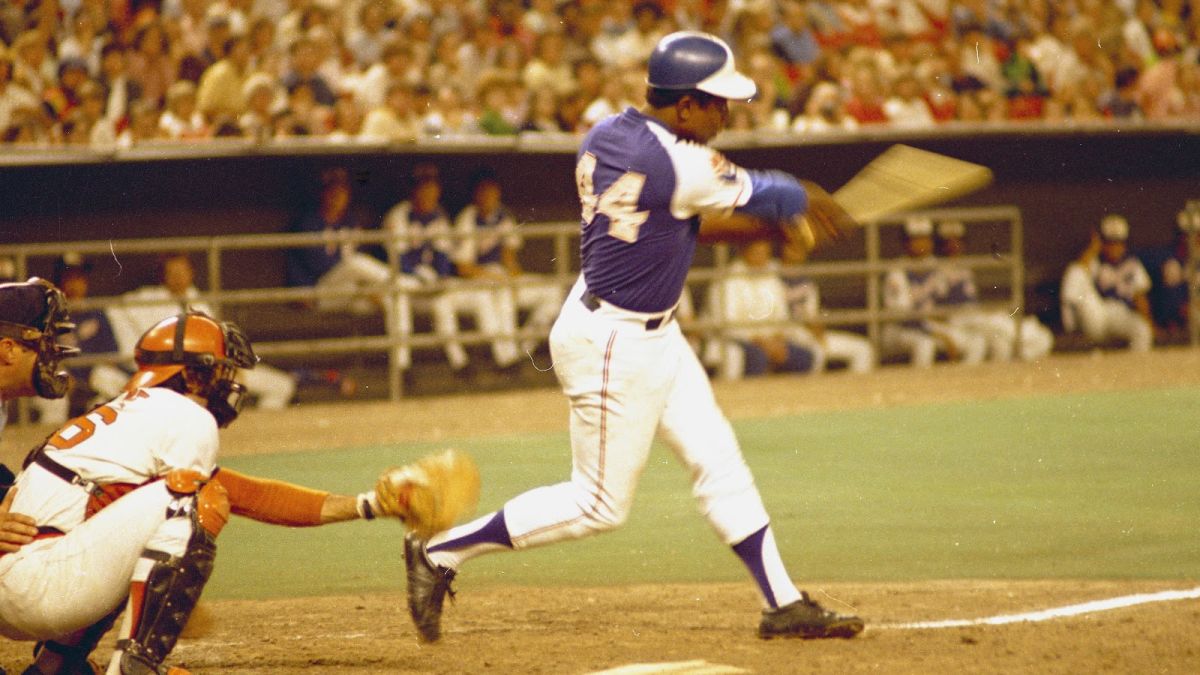
Hank Aaron, who died on Friday at the age of 86, held Major League Baseball’s home run record for 33 years between when he passed Babe Ruth with his 715th dinger in 1974 and when Barry Bonds hit No. 756 in 2007.
Yet, for as amazing as Aaron was, if you were born after his career ended, you probably haven’t seen a ton of The Hammer in action. In the 1980s, a clip of him rounding second base on his 715th home run was part of NBC’s opening for the Game of the Week, so for kids of that era, the image of those two guys who ran out of the stands to congratulate him is seared into memory more than anything else — and it was only later that millennials would learn how scary of a moment that was, that Aaron had been receiving death threats and didn’t know whether those men were on the field to cheer him on or do him harm.
The full version of the historic homer, seen on countless VHS highlight tapes, also is ingrained in the mind, Milo Hamilton calling, “there’s a new home run champion of all time, and it’s Henry Aaron!”
But there’s another call of the historic homer, by Vin Scully, that also touches on the import of the moment beyond baseball: “What a marvelous moment for the country and the world. A Black man is getting a standing ovation in the Deep South, for breaking the record of an all-time baseball idol. And it is a great moment for all of us.”
Another angle of the record-breaking blast could be seen eight years later, when Aaron appeared on Late Night with David Letterman, and a clip was used to introduce him. The interview is worth watching, not least of all for Aaron’s story about Richard Nixon.
Before hitting No. 715, of course, Aaron had to hit No. 714, and that homer hasn’t been seen nearly as much. It came in Cincinnati, at old Riverfront Stadium, and it’s a fairly incongruous image because we don’t think of Aaron much as having played in the era of AstroTurf donut stadia.
Aaron’s career had tons of great moments. It’s just that, for the most part, people still haven’t seen a lot of them. For instance, did you even know that Aaron hit a walk-off homer in the 11th inning on September 23, 1957, to clinch Milwaukee’s first National League pennant?
A couple of weeks later, on October 5, Aaron hit the first of his three World Series home runs, viewed by many from a perspective that was then novel: a center field camera.
Aaron was held off the board in the 1958 World Series, and only made one other postseason appearance in his career, with Atlanta in the inaugural NLCS in 1969. The Mets swept the best-of-five clash, but not because of any struggles by Aaron, who went deep in all three games, including one off the flagpole in dead center field at Shea Stadium in Game 3.
Aaron didn’t just hit home runs in big games. He did it for money on TV’s Home Run Derby, which pitted stars of the game against each other in a home run showdown. It wasn’t generally as exciting as the derby now seen at All-Star Games, because there weren’t so many dingers, but Aaron dominated and collected thousands of dollars, a really nice boost at the time, including with his victory over another recently departed Hall of Famer, Al Kaline.
As his career wound down, Aaron returned to Milwaukee to play with the Brewers, and that brought another couple of moments that aren’t just rare to see, but are odd to think about, like Aaron going deep at Fenway Park and getting a standing ovation.
Fenway wasn’t the only place where Aaron could reach the streets. He also did it in his Atlanta days when he went to Wrigley Field.
The final home run of Aaron’s career came back at County Stadium, with a swing that looked just the same as it did when he started his career more than two decades earlier.
For a lot of us, though, there’s no sense of what it was like to watch one of the greatest of all time from the stands. Maybe it’s fitting that the best video to try to capture that experience, from Shea Stadium in 1973, is a little blurry, a little washed out, but still has a feeling about it of watching something special…
A legend of the game, and of America, Aaron will be sorely missed.
This article is auto-generated by Algorithm Source: deadspin.com


